Graffiti and other art
at, with, about, next to the
Berlin Wall
Johannes Stahl
Based on a lecture given
13.8.09 for Goethe-Institut Stockholm
Photos (if not mentioned otherwise) (c) Johannes Stahl
Go to German version
Borders have precise
functions: they should show where one area stops and the other
begins. They can control the exchange between two areas. From the
originator's point of view the border should protect the good (which
mainly is the own) against the bad (which normally is the other's).
Last not least walls often have the task to protect against insights.
Pictures on walls may have the opposite function. There are few cases
where this can be seen as clearly as in the case of the Berlin wall.
This wall had to do with Germany in different ways including some
cultural items: a typical case for the Goethe-Institut.
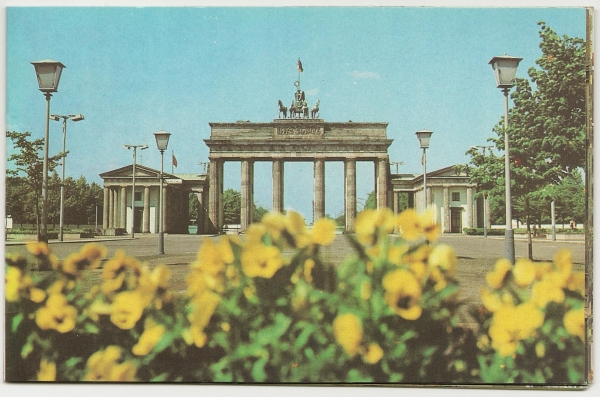
Brandenburger Tor, as presented in an
official GDR tourist guide, about 1984.
A tricky photographers
standpoint makes the wall nearly unseen.
In 1985 the City of
west-Berlin used the twilightical monument officially for self
representation. Citation from a tourist expo in Marburg, Western
Germany, breathing cold war in 1984:
"The bald plains are
spaces for artists and litterers,for slogans pro and contra, for
predictions and nonsense. Bold roughness against tristesse. The
colourful scribblings sharply accentuate the sterile, cold-heartedly
planned concrete which searches the perfection for the line in the
sand. Behind the colourful liveliness lies the death belt."
Beuys
As
early as 1964 Joseph Beuys had forced an artistic overcoming of the
wall suggesting „Elevation of the Berlin wall by 5 cm (better
proportion!)“ This is to be found as a notice for the ministry of inner
affairs of the GDR. In explaining this strange-seeming suggestion, he
stated: „This is a picture and should be looked at like a picture.” In
two so called "questanswers" he explained that his item was not the real
wall but the inner wall. „Looking at the Berlin wall from a point of
view which only takes regards of the proportion should at least be
allowed. It unloads the wall at once. By inner smile. Extincts the
wall. You don't get fixed at the real wall. It is being directed to
this wall in spirit and to overcome this is but the main point. (...)
If I come to Berlin, after 5 minutes someone urges me „Have You been to
the wall?“ Yes, I know this wall by inner experience. I know for
certain what it is, this wall. (...)““
Beuys'
statement leads us in several directions: the wall as a parable for
visibility, the question of art, the political question of Germany and,
with a certain stress, the questions of ourselves.
The so-called german question
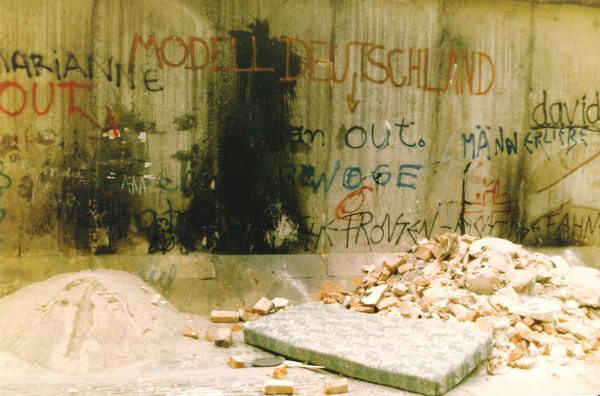
Modell
Deutschland, 1983.
In
1983 this special statement could be found. It pronounces the rubbish,
construction waste and extinct fire in front of the wall with an arrow
and crowned this scenery with the label "MODELL DEUTSCHLAND". Asides
that it was a parody citation of an election slogan in 1980, it seems
to give a clear view of what is called officially „state of the
nation“. Question is if one always can see the state of the nation at
the way how it treats its borders (or its walls). In 1983, west Berlin
officials began to rediscover the potential of this inner-city ground;
same paradigmatic architecture models were put up and the situation was
designed a little cleaner.
In January 1990 the wall became transparent.
Pictures:
objects You can see
This leads us to the second
question: visibility. Of course many pictures landed on the wall.
What they tried to make transparent are very different purposes. It
was a notable fact how many graffiti made the Berlin wall and the
situation to their own item. Asides statements like "this is the
Berlin wall" some Graffiti focus on situations, where the state
border wall was confronted to a church wall next to it. Here you
would find the sentence: "This is a wall too".
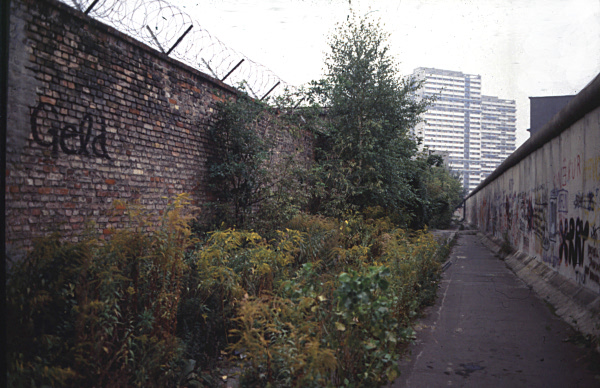
Geld, 1987
Even
more laconic the statement "Geld" at a factory wall. It turns the small
way between the two walls into a tension space: at one side the "anti
fascist protection wall", at the other side a wall protecting
"capitalist" property. It
might be worth citing the juristic sentence to Harald Naegeli, in these
days definitely the most prominent European spraycan artist from 1981:
Harald Naegeli has – for years and with special sharpness, consequence and regardlessness -
managed to make the Zurich inhabitants insecure and to shatter their faith in the invulnerability
of property which is based in our law."
Politics: Cold War
Other
projections on the wall show it as prison wall (we have to remember
we are in the cold war and asides art propaganda was a daily
procedure).It is not only open, if GDR or Westberlin were prisons but
which were the inner prison walls.
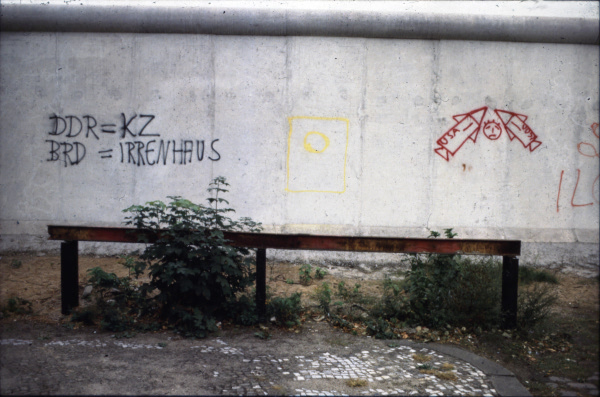
Ansichten, 1983
One possibility is the equation GRD=concentration camp / FRG=House for the Insane.
Even
if it is a typical cold war confrontation, it is a system reflection at
least. Prisoner clothes show Westberliners their existence. Or does it
claim the East to be imprisoned?
Other
Graffiti have the item of the killed at the wall. GDR Border soldiers
had a command to shot at "Refugees from the republic".
How to overcome

Anarchist, 1983
Asides
this, the wall was seen as a real obstacle in the way, resulting in
many, many ways how to overcome it. Naive balloon travels or an
anarchist self portrait on a ladder, with stones in his hand, tell the
wall “I'll pass You one day”.

Some Graffiti constructed life before or after the Mauer or a wide landscape, with the comment: leave the land to the children.
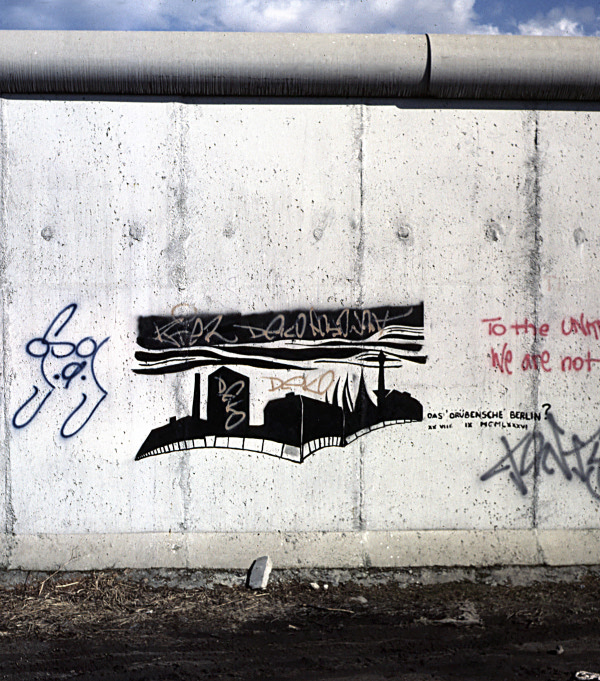
Counter perspective, 1987
A
small Graffito at the Wedding wall deserves a special mention among the
mass of graffiti constructing insight. Signed and titled "Das
druebensche Berlin", it takes the counter perspective to the normal
wall projections and represents Westberlin seen from the eastern Part
of the town. The Silhouette of the Western part is given in a technique
like a woodcut and in style like many town pictures forming something
that was called "Berliner Schule" in the East German academic art world.
Art history ; Art conceptions
Graffiti cultures often offer
a multi focus history of art. In the Case of the Berlin wall, there
are literal approaches, a slave-like or monk-like transcription word
by word. Political tendencies can easily be found in the art
competitions of the Haus am Checkpoint Charlie. As Ideologists had
erected the wall it always remained object for other ideologists.
Michael Nungesser called the wall a “chaotic Gesamtkunstwerk”.
As
the wall and its Graffiti are history, even more traditional art
historians begin to be occupied with it. They have now a historically
locked research field. But there are arguments: Have the objects been
treated in a correct way? Did the art aspect and the historical
importance have their proper shares? Is what they call research depth
adept to the item? And, more methodically: Do our perspectives, our
methods need borders themselves – which can be an explosive
question specially to this research item?

Mauerkunst = Lebenskunst; Is Wall art equal to the art of living?
There have been quite a lot artists who were occupied with the Berlin
wall. Representations by artists like Henri Cartier-Bresson, Oskar
Kokoschka, Wolf Vostell, Karl-Heinz Hödicke, Shunkichi Tajiri or Rainer
Fetting, this is a wide field. Even though we should focus on
graffiti-related phenomenons, it is worth taking a look to a postal
card being sent from east to west these days (and no one knows which
trouble this might have caused).
picture follows
Christina Pohl: Postcard to the author,
march 1986
It
shows a barrier of wooden soccer players, known as “Mauer”. In the
centre, a then-common eastern stamp is placed, reading: “On the watch
for peace and socialism”. The reading between the lines might be even
more interesting. Specially in critical circles of GDR, things like
this marked a special way of cultural communication.
The berlin Wall / USPs
follows
Away from this art-related
statements why we are still occupied with this wall today has to do
with the rare state that it was a wall of widely free access and free
expression. Of course it created not only aphorisms worth being
transferred to our presence, but also many very ephemere notes.
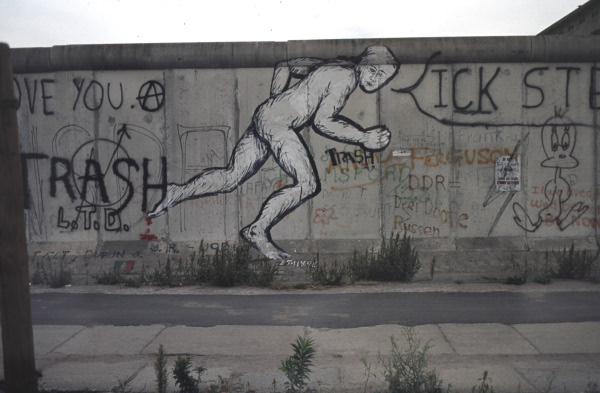
Jonathan Borofsky: Running man, 1982. State in 1983
American
artist Jonathan Borofsky painted his "Running Man" 1982 for the art
exhibition „Metropolis“ in Martin-Gropius-Bau . With black outlines and
white fillings, he occupies four wall segments. A man runs towards the
wall and looks around like being fleeing. The wall doesn't offer any
coming through; his attempt is damned to fail. Whether you point at the
political impact or the private situation: it is a definite tension
between the picture and the urbanistic situation it has been placed in.
But change is a basic fact to these pictures. In 1983, someone had
added a bubble saying “Ick steh uff Berlin”, a then popular New Wave
Hit with rather few political impact.
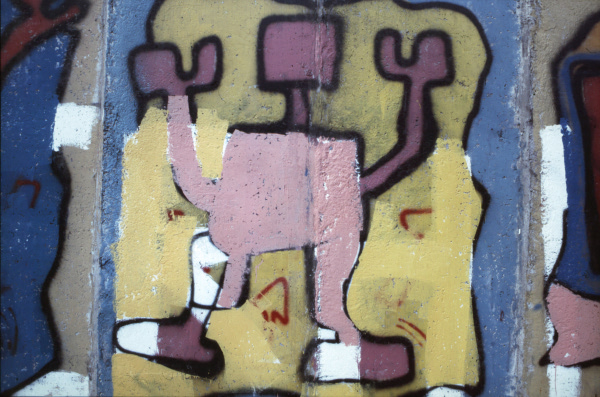
Thierry Noir: Reparatur
We
know what was fresh yesterday might have been overpainted or at least
changed the next day. Thierry Noir is worth being mentioned in this
question: reparing and conserving the state of his things, he could
remain one of the more lasting people at the wall.
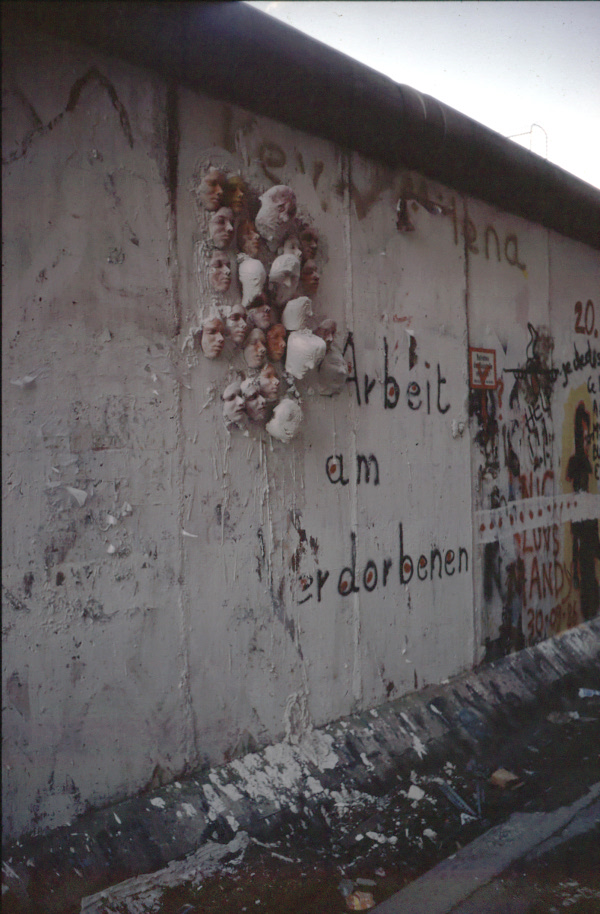
Peter Unsicker: Working at the rotten, March 1987
A
different approach can be seen in Peter Unsicker dealing with this
factor. For example, with his plastic use of the wall in “Arbeit am
Verdorbenen”, he changed the appearance, giving
the process a both artistic and political sense.
Painting Over

1986 the late Keith Haring
worked for "Arbeitgemeinschaft 8. August im Haus am Checkpoint
Charlie”. His big mural next to it had been announced as a public
event. An American military helicopter surveyed this illegal
procedure. Haring sprang during his painting several times back, with
an notable impact on the journalists, and pronouncing the 3 meters
between wall and real GDR state border. HARINGs mural shows a peoples
chain made of red and black pictographs. On yellow ground – that
had been prepared before and covered Thierry Noir's Miss Libertys it
symbolizes an all German fraternization. For "Haus am Checkpoint
Charlie" it gave a very popular piece of art that was
represented widely since then, with foreseeable effects in the art
world and the public views.
Maybe more relevant are the
nearly unknown drawings HARING made at the less frequented Weddinger
Mauer, possibly in 1984, when he left similar drawings in Cologne.
In
a witty way they deal with existing Graffiti, capture them and lead
them to totally different meanings. If You consider the partly
aggressive behaviour among other Graffiti at the Berlin wall one of its
values is that Haring brings a pictural communication to life.
Style
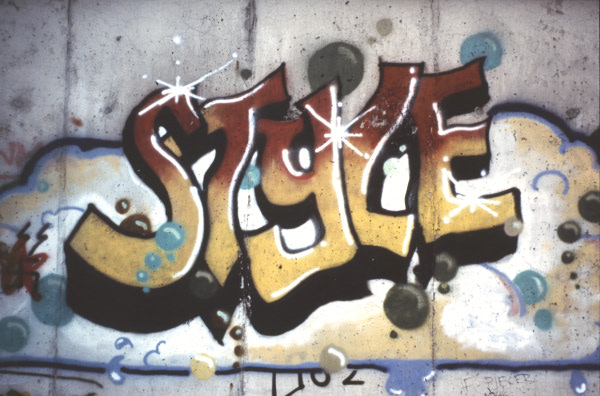
ZEPHYR: Style, 1983
Both
sensuel and intellectual is a "Piece" of New Yorker Spraycan artist
ZEPHYR at the wall as early as 1984. His word "STYLE" uses a key
argument of the New Yorker writers. By putting it in the context of the
Berlin wall it widens the inner discussion among writers and it
enriches the discussion about the design and the purpose of the Berlin
wall. Since 1986 the impact of "Pieces" following New York cults have
widened.

Style, 1987
Even
if the Berlin wall seemingly wasn't as attractive as having pieces
running on rails somewhere, some rather prominent writers have been
enriching the Berlin wall. Even here You come over the key term of New
York Spraycan art: Style. But of course this inner nomenclatura was ironized. Even Jenny felt able to be part of the movement.
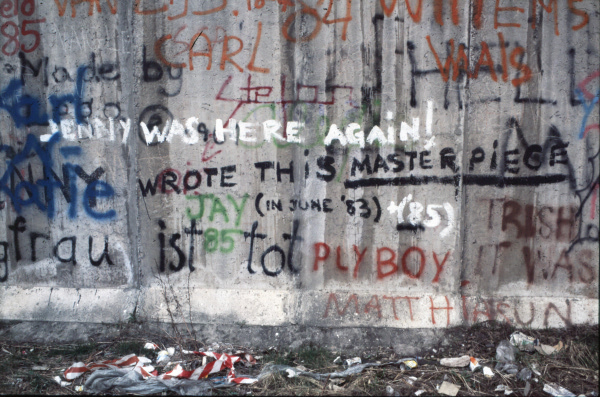
Jenny, 1983, 1985
Counterwalls
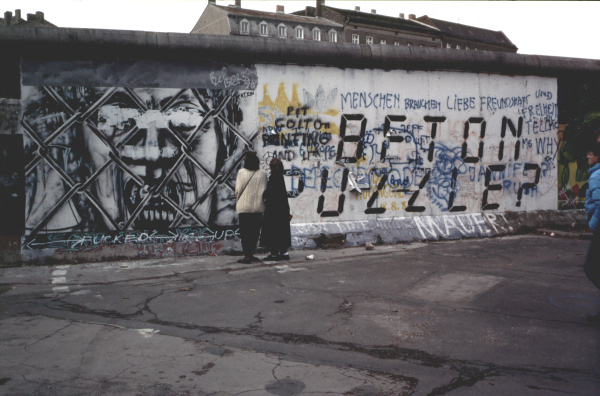
John Fekner / DAZE, 1986
New
York artist John Fekner has been occupied more often with the Berlin
wall. On occasion of the 1986 exhibition "Stadtsichten" by NGBK Berlin
he interpreted the wall as "Beton Puzzle", collaborating with artist
and writer DAZE
Together
with his cologne Collegue Peter Mönnig he constructed a piece of wall
next to the Berlin wall. Mönnig contributed flash-like wooden
sculptures that spread over the wall whereas Fekners Part was the words
"Wall", "Hall" and "A". As "Wallhalla" they refer to nordic myths and
the traditions of cultural, political and idealistic loaded Hall of
Fames. In writers circles the „Hall of fame” has a different sound.
Berlin Wall: some transfers
The
Berlin wall was a perfect mixing place for all sorts of wall uses. This
special mixture and the changes one could see every time he came to the
wall made it unique – and this divides it from other places where one
pictural culture could be dominant.
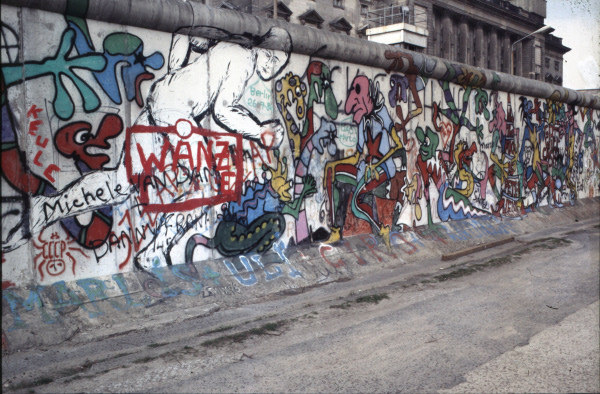
John
Borofsky's running man an his surroundings in April 1986.
Maybe “wild
style”, following the idea of “Gesamtkunstwerk” could be like
that.
As a perspective how to handle
the wall an eastern Berlin artist Christina Pohl told me in 1985: If
our leaders find out which important artists have been painting on
the wall and what the financial value of it is now, they will replace
those parts by new ones and sell the painted ones in foreign
countries, like the Nazis did with what they called „Entartete
Kunst“.
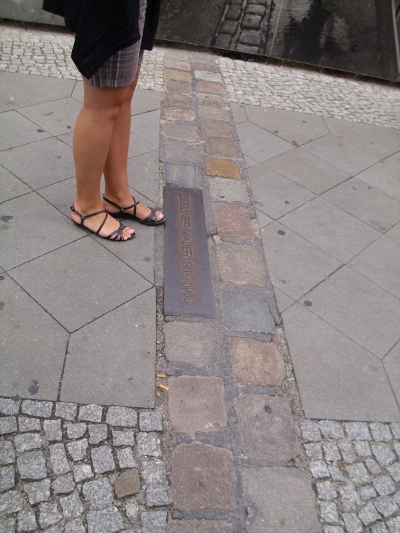
2009
As we all know, today the situation is different. The wall
underwent a change of medial styles, from architectur via painting
and (thanks to the “Mauerspechte”) sculpture and finally edition.
Now it seems to be missing, at least for the touristic conception of
a city which still uses many pictures of it. It is not only a problem
to produce new sacred relics. For tourist masses, localizing this
extended monument is complicated. Relocating it elsewhere – or at
least correcting the traffic-hindering position? Focussing on East
Side Gallery? Joseph Beuys knew about some inner walls. In this
concern there are remains much higher than the original proportions
made You think. Before too much consensual thinking sweetens this
evening too much, let me cite a drawing by Markus Vater, representing
the wall and some bowed lines over it.
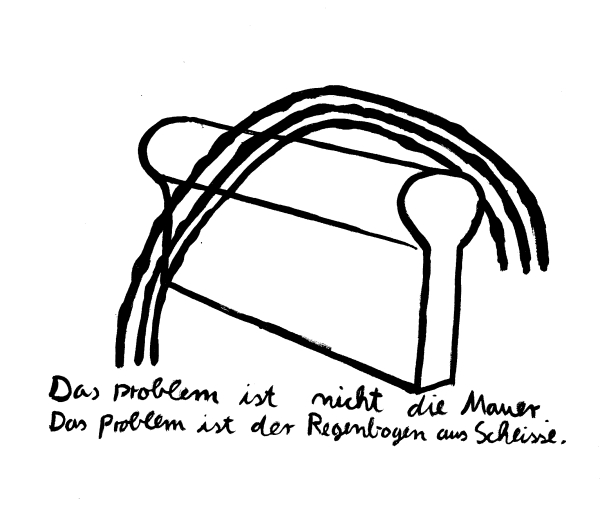
Markus Vater, The Problem is not the wall. The problem is the rainbow made of shit. 2003. Oil on Canvas, 100 x 130 cm. From: Markus Vater. Black
Mountain. Ausstellungskatalog Museum Baden, Solingen 2007, S. 28.

















